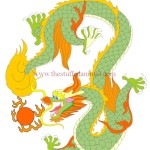The people of China have a long held belief that they are descendents of the Chinese dragon, a tradition that is firmly embedded in their culture and one that is encountered across all aspects of Chinese society and in the minds of its people. In China the Chinese dragon is held in high esteem for its dignity and power for good.
In primitive times people have regarded the Chinese dragon as an auspicious creature with the power to bless and influence their lives. As tribes fought for domination and came to be united under a common banner the Chinese dragon was adopted as a national icon. Such was the mysterious creature’s power it was regarded as the god of rain, thunder, the rainbow, and the stars. In a society that was founded upon agriculture and animal husbandry totally reliant upon its natural environment and in particular the climate, the Chinese dragon was worshipped as the source of all that was beneficial to communal well being. This concept has been sustained for thousands of years as more and more deification was bestowed upon the Chinese dragon ranging from being a bringer of joy to prophecy and miracles. With the establishment of a feudal society, emperors compared themselves to the Chinese dragon thereby making it the exclusive symbol of imperial majesty. Anyone who subsequently used the Chinese dragon as a symbol either intentionally or erroneously could be regarded as offending their ruler and condemned to death.
There are several different kinds of Chinese dragon according to color, which may be yellow, blue, black, white or red. Of these the most highly revered was the yellow Chinese dragon and so each emperor wore a gown decorated with a yellow Chinese dragon pattern.
Although there are differences in appearance, the basics are similar. This is because it is a combination of the features of animals with which people were familiar. A Chinese dragon has a protruding forehead indicating wisdom and antlers signifying longevity. Its ox’s ears denote success in the imperial examination; it has tiger’s eyes as a sign of power; eagle’s claws showing bravery; while a fish’s tail implies flexibility and the horse’s teeth are a mark of diligence and so on.
The most vibrant and spectacular way of expressing fondness for the Chinese dragon is the Chinese dragon dance. This has evolved from what was a ritual rain dance into a popular entertainment performed during the period from Spring Festival until the Lantern Festival. The second day of the second lunar month is the Han people’s special time – ‘Chinese dragon Heads-raising Day’. People could not tonsure their hair from the start of the lunar New Year until then. The activities for celebration are still for a good rain. Other big festivals related to the Chinese dragon include the Chinese dragon Boat Festival and those of ethnic groups like Zhuang, Yao, Hani, and so on.









发布产品咨询